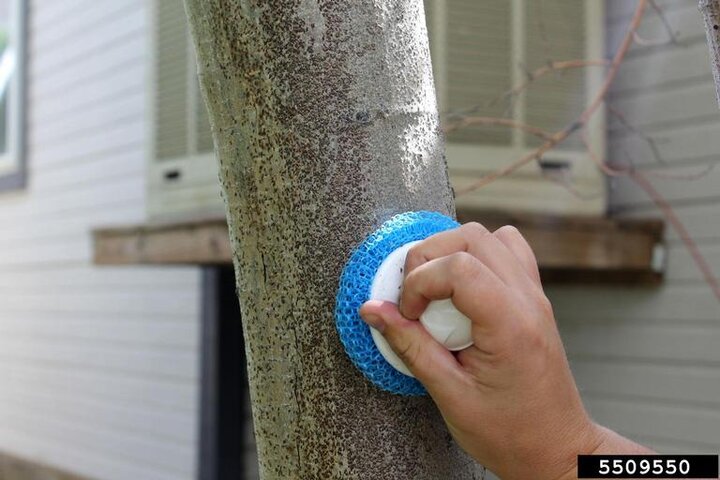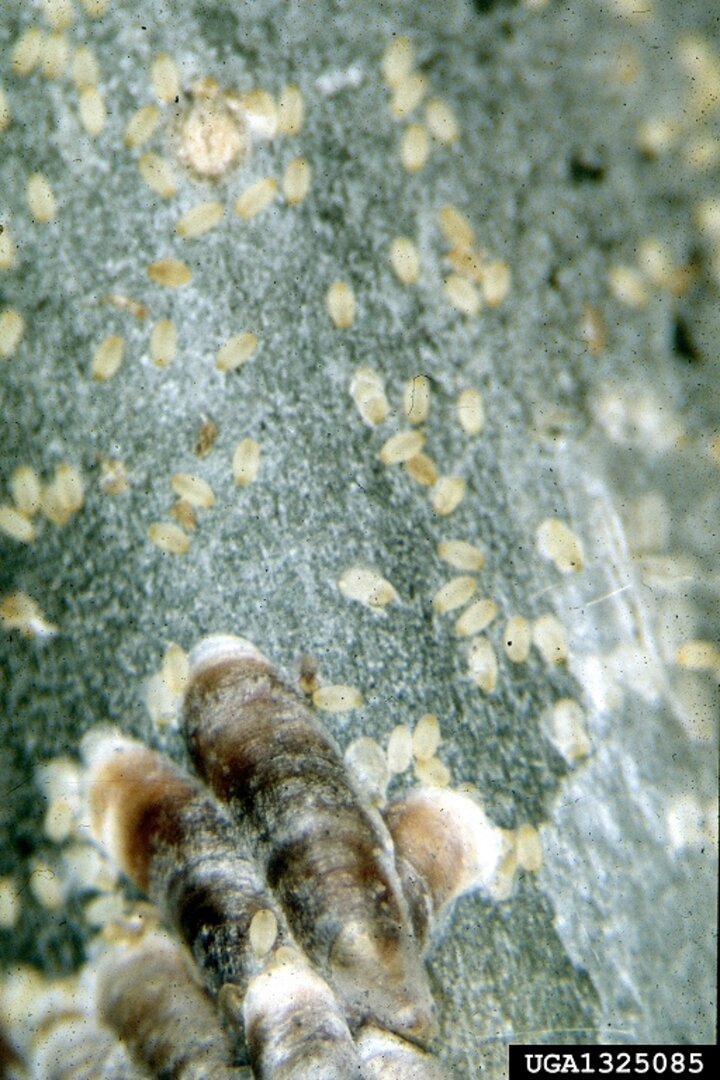Sarah Browning, Nebraska Extension Educator

The image shows a mature female oystershell scale flipped to show the eggs beneath. Image by Whitney Cranshaw, Colorado State University, Bugwood.org.
Oystershell scale is a very secretive little insect that usually goes unnoticed. But despite it’s tiny size, this insect can cause significant damage in trees or shrubs. Some gardeners aren’t even aware the insects are present as they prune out dead branches the insects have killed. If you had branches die on a rose, dogwood or lilac shrub last year, inspect the base of branches for the presence of oystershell scale.
Description
Scale insects are very unusual little critters, classified in the order Hemiptera, which also includes insects such as aphids, leafhoppers, and cicadas. Insects in this group all have sucking mouthparts. There are over 8,000 species of scale insects, but oystershell scale is one of the most common in Nebraska landscapes. It’s named for the look and shape of the female insect’s hard, protective shell, which resembles a tiny, 1/16-1/8 inch, elongated oystershell.
Oystershell scale can be found on ash, maple, lilac, cotoneaster, dogwood, poplar, willow; fruits such as apple, pear, apricot, plum, raspberry, currant and grape; and many other hardwood trees and shrubs. The insects are not obvious and can build up large numbers on trunks and twigs before being noticed. A heavy infestation will weaken the affected plant, causing it to drop leaves. Branch and plant death may result from large-scale infestations.
The type of oystershell scale most commonly found in Nebraska has one generation per year, which hatch from late May into June.
Newly hatched scale insects are called "crawlers", and they are mobile for only a short period. They are pale in color and smaller than a pinhead in size. Within a few hours after hatching crawlers find a suitable location, usually on a shaded area of the tree. They insert their mouthparts into the plant, begin to suck sap and soon molt, losing their legs. From this point on, most scales are immobile for the rest of their lives. Within a week they are covered with a waxy scale covering that provides protection from most insecticides. Winged males emerge during summer. Female insects lay eggs in fall, and then die; leaving their eggs to overwinter under the mother’s shell. Old scale shells will stay attached to the plant’s branches for several years before falling off.

Control
To control these insects, begin by pruning out heavily infested stems during the dormant season. Pruning could be done anytime between now and late March.
Another method of control with light infestations is to gently scrape away scales by lightly rubbing plant bark them with a plastic dish pad. This will expose overwintering eggs, by removing their protective covering. Spray twigs, branches and stems with horticultural oil in the spring before the buds expand, March to early April. Some plants may be sensitive to oil sprays, so make sure your plant is listed on the product label before spraying.

Spray plants again when insects are in the crawler stage, late May to early June. To determine when the crawler stage is emerging on your plants, place double-sided tape on several plant stems, and monitor for the presence of the tiny new insects stuck on the tape. Make a repeat application in 7 to 10 days.
Inspect plants in August for signs of any additional new crawlers. (This would indicate the presence of a less common type of oystershell scale in your landscape.)
Insecticides labeled for control include horticultural oil, insecticidal soap, acephate, bifenthrin or malathion. When making applications to fruit trees, be sure the insecticide is labeled for food producing plants. Read and follow all pesticide label directions.
Images
1.Whitney Cranshaw, Colorado State University, Bugwood.org. Removing scales from quaking aspen with a dish scrubber.
2.Whitney Cranshaw, Colorado State University, Bugwood.org. Immature nymphs recently settled into a feeding location.
Search Our Archive
Associated Video
Scale Insect Control
Nebraska Extension Entomologists Jody Green and Jonathan Larson discuss scale insects and their control.